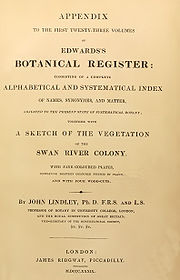
A Sketch of the Vegetation of the Swan River Colony
Encyclopedia

John Lindley
John Lindley FRS was an English botanist, gardener and orchidologist.-Early years:Born in Catton, near Norwich, England, John Lindley was one of four children of George and Mary Lindley. George Lindley was a nurseryman and pomologist and ran a commercial nursery garden...
on the flora of the Swan River Colony
Swan River Colony
The Swan River Colony was a British settlement established in 1829 on the Swan River, in Western Australia. The name was a pars pro toto for Western Australia. In 1832, the colony was officially renamed Western Australia, when the colony's founding Lieutenant-Governor, Captain James Stirling,...
. Nearly 300 new species were published in it, many of which are still current.
It appeared as Part Three of Appendix to the first twenty three volumes of Edward's Botanical Register, the first two parts being indices of previous volumes of Edwards's Botanical Register, of which Lindley was editor. It contained 58 pages, issued in three parts. Pages 1 to 16 were issued on 1 November 1839; pages 17 to 32 on 1 December 1839; and the remaining 26 pages on 1 January 1840. It also contained four woodcut
Woodcut
Woodcut—occasionally known as xylography—is a relief printing artistic technique in printmaking in which an image is carved into the surface of a block of wood, with the printing parts remaining level with the surface while the non-printing parts are removed, typically with gouges...
s based on sketches by Lindley, and nine hand-coloured lithographic plates, the artist and lithographer of which are unacknowledged and are now unknown. According to Helen Hewson, the woodcuts are of high quality, but the plates "do not measure up to the standard of contemporary illustration".
A Sketch of the Vegetation of the Swan River Colony represents only the second attempt to provide a flora for the colony, the first being Stephan Endlicher's 1837 Enumeratio plantarum, a Latin
Latin
Latin is an Italic language originally spoken in Latium and Ancient Rome. It, along with most European languages, is a descendant of the ancient Proto-Indo-European language. Although it is considered a dead language, a number of scholars and members of the Christian clergy speak it fluently, and...
work of which only one installment was published. Thus there were at the time a great many undescribed species awaiting publication — speaking of the (now defunct) order Stylidaceae, Lindley remarks "In Brown
Robert Brown (botanist)
Robert Brown was a Scottish botanist and palaeobotanist who made important contributions to botany largely through his pioneering use of the microscope...
's prodromus
Prodromus Florae Novae Hollandiae et Insulae Van Diemen
Prodromus Florae Novae Hollandiae et Insulae Van Diemen is an 1810 flora of Australia by botanist Robert Brown. Often referred to as Prodromus Flora Novae Hollandiae, or by its standard botanical abbreviation Prodr. Fl. Nov. Holland., it was the first attempt at a survey of the Australian flora...
forty-six species only are named for all New Holland... but I possess from Swan River alone at least forty well marked species, and there are some of Baron Hugel's with which I am unacquainted". Working primarily from the collections of James Drummond
James Drummond (botanist)
James Drummond was a botanist and naturalist who was an early settler in Western Australia.-Early life:...
, Lindley was able to publish around 280 new taxa, many of which remain current.

